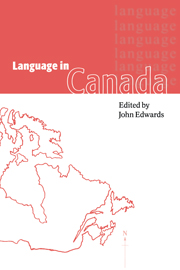Book contents
- Frontmatter
- Contents
- List of figures
- List of maps
- List of tables
- Notes on contributors
- 1 Canada
- Introduction
- 1 The foundations
- 2 The fading Canadian duality
- 3 Official bilingualism: from the 1960s to the 1990s
- 4 Official multiculturalism
- 5 Language in education: bridging educational policy and social psychological research
- 6 Aboriginal languages: history
- 7 Aboriginal languages: current status
- 8 French: Canadian varieties
- 9 French in Quebec
- 10 French in New Brunswick
- 11 French outside New Brunswick and Quebec
- 12 English: Canadian varieties
- 13 English Quebec
- 14 The teaching of international languages
- 15 French immersion in Canada
- 16 Language in Newfoundland
- 17 Language in Prince Edward Island
- 18 Language in Nova Scotia
- 19 Language in New Brunswick
- 20 Language in Quebec: aboriginal and heritage varieties
- 21 Language in Ontario
- 22 Language in Manitoba
- 23 Language in Saskatchewan: Anglo-hegemony maintained
- 24 Language in Alberta: unilingualism in practice
- 25 Language in British Columbia
- 26 Language in the Northwest Territories and the Yukon Territory
- Index of names
- Index of language families, languages, dialects
- Index of subjects
7 - Aboriginal languages: current status
Published online by Cambridge University Press: 18 February 2010
- Frontmatter
- Contents
- List of figures
- List of maps
- List of tables
- Notes on contributors
- 1 Canada
- Introduction
- 1 The foundations
- 2 The fading Canadian duality
- 3 Official bilingualism: from the 1960s to the 1990s
- 4 Official multiculturalism
- 5 Language in education: bridging educational policy and social psychological research
- 6 Aboriginal languages: history
- 7 Aboriginal languages: current status
- 8 French: Canadian varieties
- 9 French in Quebec
- 10 French in New Brunswick
- 11 French outside New Brunswick and Quebec
- 12 English: Canadian varieties
- 13 English Quebec
- 14 The teaching of international languages
- 15 French immersion in Canada
- 16 Language in Newfoundland
- 17 Language in Prince Edward Island
- 18 Language in Nova Scotia
- 19 Language in New Brunswick
- 20 Language in Quebec: aboriginal and heritage varieties
- 21 Language in Ontario
- 22 Language in Manitoba
- 23 Language in Saskatchewan: Anglo-hegemony maintained
- 24 Language in Alberta: unilingualism in practice
- 25 Language in British Columbia
- 26 Language in the Northwest Territories and the Yukon Territory
- Index of names
- Index of language families, languages, dialects
- Index of subjects
Summary
There is general agreement that Canada's aboriginal languages may be grouped into eleven distinct families and isolates. Cook (this volume) provides a list of over fifty aboriginal languages and indicates in which areas they are spoken; none of the families is uniquely contained within the Canadian borders. The Eskimo-Aleut family is represented by Inuktitut, a dialect continuum stretching across the Canadian Arctic (and into Alaska), also referred to as Eskimo. Languages belonging to the Iroquoian family are located in the provinces of Quebec and Ontario. The Algonquian family is represented by a wide array of languages spoken in a domain stretching from Alberta to the Maritimes. The remaining eight language families are to be found only in western Canada. Siouan and Athapaskan languages are spoken in the prairies, but the latter group of languages is mostly found in the Northwest Territories, the Yukon and British Columbia. Six language groups (three isolates, Haida, Tlingit and Kutenai, as well as the Salishan, Tsimshian and Wakashan families) are to be found only in British Columbia, an area of great linguistic complexity.
WHO ARE THE CANADIAN ABORIGINAL PEOPLE?
According to the 1991 Canadian census, slightly over one million (1,016,335) people declared aboriginal origins, roughly 3.8 per cent of the Canadian population (Statistics Canada, 1995).
Information
- Type
- Chapter
- Information
- Language in Canada , pp. 144 - 159Publisher: Cambridge University PressPrint publication year: 1998
Accessibility standard: Unknown
Why this information is here
This section outlines the accessibility features of this content - including support for screen readers, full keyboard navigation and high-contrast display options. This may not be relevant for you.Accessibility Information
- 6
- Cited by
